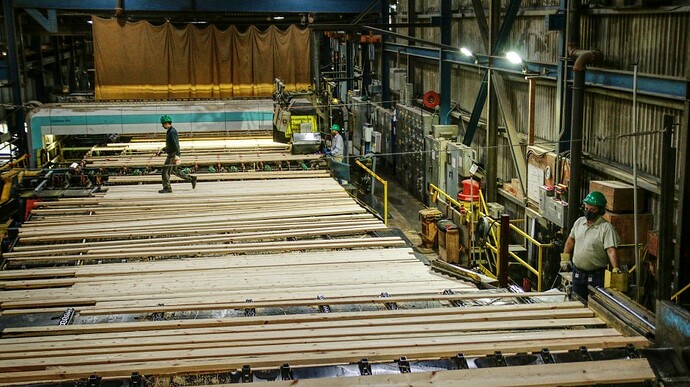Lumber prices have somewhat stabilized this year after years of unusual volatility during the pandemic, making it easier for B.C. forestry companies to plan their business activities, analysts say.
A thousand board feet (mbf) of mixed species lumber (spruce, pine, fir) was selling last week for US$400, down nearly US$100 from August, mainly due to it being low season for construction. But prices are expected to rise in February when orders for lumber products to fulfill U.S. housing demand increase, according to Keta Kosman, publisher of Madison’s Lumber Reporter.
“There’s a couple of things that are happening. One is that there is a long-term shortage of homes available based on the demographic,” said Kosman.
It is estimated that there was a 6.4-million-home gap between single-family home construction and household formations in the U.S. between 2012 and 2022. That gap is down to 2.3 million homes if multi-family construction is included, according to Realtor.com analysis.
“There is a high amount of homes that are starting to age that are 70 years and older, that will either have to be actually torn down and rebuilt,” Kosman said. “These things both mean lumber sales.”
In February, prices start to increase as large U.S. homebuilders order wood so they can begin construction March, April and May, she explained.
Lumber prices ranged from US$300/mbf to US$450/mbf in 2023. Russ Taylor, president of Russ Taylor Global Wood Business and Market Consulting, said he expects prices to average about US$390/mbf for the year.
“We are currently in the seasonally slow period of the lumber market cycle. October normally experiences a low – and prices are currently moving lower – before rising some time in November through January. I expect this normal cycle to persist over the next three months with little volatility expected,” said Taylor.
“North American lumber markets can be described as relatively balanced. Demand is steady and lumber production is attempting to balance with demand. As a result, prices are bouncing around only a little bit.”
Normality in the market follows three years of pandemic price volatility. At peak in 2021, lumber prices reached a record high of US$1,600/mbf.
This price volatility was “terrible” for the industry, Kosman said, because businesses and customers couldn’t plan effectively.
“Right now [the price is] still low and that makes sense because the economy is still slow,” she said. “It’s what we call the new reality, new normal.”
Kosman said the trend line for lumber prices now “almost exactly” matches the trend line in 2019, with slightly higher prices due to higher sawmill production costs.
The anticipated average price of US$390/mbf in 2023 means that B.C. sawmills would have operated “at a loss for much if not all of the year,” as their break-even price is US$444 to US$493 per thousand board feet, according to Taylor.
B.C. lumber production is seeing the greatest reduction in North America, down by almost 10 billion board feet – or 60 per cent – in 2023 compared to 2006, said Taylor.
“This is a result of the wind down of the Mountain pine beetle epidemic but now being accelerated by many B.C. government forest policies plus ongoing challenges of reduced timber supplies from other beetles and more forest fire implications,” he said.
B.C. sawmills that are still operating are looking to scale up in 2024 as prices rise.
“For sawmills, the highest cost is energy and labour.… Our mills here in B.C., especially the large ones, are optimized to run at a high capacity so they are more efficient if they can run at 90 per cent,” Kosman said. “They have been running barely 75 per cent.”
“They don’t want to over produce because then the price will go down. So, they’re waiting. Everything depends on what’s going to happen next year; 2024 is going to be a good year for U.S. housing.”
